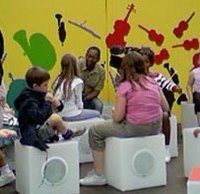It's encouraging people to get into music …
 Are sound samples the alchemy that will turn the base metal of dwindling audiences and falling CD sales into the gold of new young audiences and profitable classical music downloads? After the digital orchestra playing Beethoven and the LSO playing NOTION another London orchestra has joined the sound samples bandwagon. But there is a big difference between the Philharmonia Orchestra’s new Sound Exchange and the other ‘cash for samples’ projects that are currently doing the rounds. Sound Exchange is part of an pioneering new music education website aimed at the hard to reach young audience, and at the centre of it is PLAY.orchestra, a collaboration between the Phiharmonia Orchestra, the South Bank Centre and Central Saint Martins College of Art and Design.
Are sound samples the alchemy that will turn the base metal of dwindling audiences and falling CD sales into the gold of new young audiences and profitable classical music downloads? After the digital orchestra playing Beethoven and the LSO playing NOTION another London orchestra has joined the sound samples bandwagon. But there is a big difference between the Philharmonia Orchestra’s new Sound Exchange and the other ‘cash for samples’ projects that are currently doing the rounds. Sound Exchange is part of an pioneering new music education website aimed at the hard to reach young audience, and at the centre of it is PLAY.orchestra, a collaboration between the Phiharmonia Orchestra, the South Bank Centre and Central Saint Martins College of Art and Design.56 colourful plastic cubes and three hotspots are laid out on a full size orchestra stage on the Royal Festival Hall terrace (photo below), and each cube contains a light and a speaker -
 sit down on the cube or stand in the hotspot and the instrument from that position will sound, becoming part of a full orchestra. The more people taking part, the more layers of the score are revealed. The project opened on August 18 and music performed will range from specially commissioned works to a traditional repertoire taken from the Philharmonia's 2006/07 season. On the orchestra's Sound Exchange website every instrument has been sampled in different musical styles and dynamics, and the samples are available as free downloads. Bluetooth mobile phones users can get involved by recording their own sound and sending them to the online sample library.
sit down on the cube or stand in the hotspot and the instrument from that position will sound, becoming part of a full orchestra. The more people taking part, the more layers of the score are revealed. The project opened on August 18 and music performed will range from specially commissioned works to a traditional repertoire taken from the Philharmonia's 2006/07 season. On the orchestra's Sound Exchange website every instrument has been sampled in different musical styles and dynamics, and the samples are available as free downloads. Bluetooth mobile phones users can get involved by recording their own sound and sending them to the online sample library.It’s too early to tell whether the Philharmonia’s innovative thinking will convert the base metal, but there are already some glimmers of hope. As part of the PLAY.orchestra project, 18-year-old Adam Nicholas from Suffolk (photo above) has been commissioned to compose a piece to be 'played' through the cubes after sending the orchestra samples of his work. Adam has been involved in other Philharmonia projects as a student and is the youngest of only six composers asked to compose a new piece of music. He has to create his two-and-a-half to three-minute piece using the samples sent in by the public and it will be played for a week from September 23.
Adam, who is also working on two albums of his own, said: “I'm really excited. It's really good and it opens music up to the public. You see people smile when they sit on the boxes. It's a mad opportunity and it's with the Philharmonia as well, which is really big. It's to encourage people to get into music. A lot of people my age and younger are not really interested in classical music. Stuff like this, and people like me, can bring the two together."
* Sound samples can be e-mailed to play@philharmonia.co.uk or log on to the Sound Exchange website.
Image credits - Adam Nicholas from EDP, PLAY.orchestra from Philharmonia. Any copyrighted material on these pages is used in "fair use", for the purpose of study, review or critical analysis only, and will be removed at the request of copyright owner(s). Report broken links, missing images and other errors to - overgrownpath at hotmail dot co dot uk
But the Philharmonia aren't the only ones with this idea, you read about it first On An Overgrown Path at Now the audience composes the music









Comments